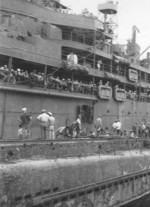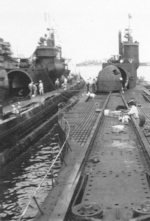I-401
| Country | Japan |
| Ship Class | I-400-class Submarine |
| Builder | Sasebo Naval Arsenal |
| Commissioned | 8 Jan 1945 |
| Sunk | 31 May 1946 |
| Displacement | 5,223 tons standard; 6,560 tons submerged |
| Length | 400 feet |
| Beam | 39 feet |
| Draft | 23 feet |
| Machinery | Four diesel engines totalling 7,700hp, electric motors totalling 2,400hp |
| Bunkerage | 500,000gal fuel oil |
| Speed | 18 knots |
| Range | 37,500nm at 14 knots |
| Crew | 157 |
| Armament | 8x533mm forward torpedo tubes, 20x533mm Type 95 torpedoes, 1x140mm gun, 3x25mm machine guns, 1x25mm machine gun |
| Submerged Speed | 6.5 knots |
| Aircraft | 3 M6A1 Seiran seaplanes |
Contributor: C. Peter Chen
ww2dbaseSubmarine I-401, along with her sister submarines, were the largest submarines in the world until 1965. The size was due to her unique mission of bringing multiple attack aircraft to the shores of the Americas. Built at Sasebo, Japan, she was commissioned in Jan 1945 at Kure Naval District, Japan under the command of Lieutenant Commander Nobukiyo Nambu. She conducted training shortly after with Submarine Squadron 11 along with her sister submarine I-400. On 19 Mar 1945, during an American aerial attack on Kure, I-401 was strafed while in drydock but not damaged. On 11 Apr, she ran aground outside of Kure en route to Dairen, Manchuria, China, but was able to break free without damage. On the next day, she was hit by a naval mine, forcing her to return to Kure for repairs. In May, she was fitted with a breathing tube that allowed her diesel engine to operate while she was submerged. On 4 Jun, she arrived at Nanao Bay for training, launching six M6A Seiran aircraft operated by the 631st Naval Air Group.
ww2dbaseI-401 was originally designed to attack faraway targets such as American coastal cities or the Panama Canal, but by early Jun 1945 such a mission would mean little, and a target much closer to Japan was chosen. On 20 Jul 1945, she was dispatched from Maizuru harbor during Operation Arashi in a force of two I-400-class submarines (I-400 and I-401, each carrying three aircraft) and two modified AM-class submarines (each carrying two aircraft) to attack the American anchorage at Ulithi in the Caroline Islands. On 21 Jul, she arrived at Ominato, Honshu, Japan, where all crew were granted one day's leave while all submarines in the group were painted with fake American markings. On 23 Jul, she departed at 1600, taking a slightly different route toward Ulithi than the other submarines to avoid detection. En route, she encountered an American tanker without escort, but decided against attacking the tanker and jeopardizing the primary mission. On 14 Aug, she arrived at a rendezvous point near Ponape where she was to regroup with I-400, but I-400 was nowhere to be found; according to plan, the attack was postponed until I-400 arrived. Shortly after the postponement decision was made, the Japanese surrendered, ending the Pacific War. I-401's mission was aborted on 18 Aug. Some of her crew entertained the thoughts of heading to Truk in the Caroline Islands and continue fighting, but ultimately obeyed Nambu's decision to comply with the surrender order. She fired her 20 Type 95 torpedoes and launched their aircraft into the water on 22 Aug 1945 before surrendering to the Americans on 29 Aug. All of I-401's codes, logs, charts, and documents were also destroyed. She was surrendered to submarine USS Segundo; Lieutenant Muneo Bando, I-401's navigation officer, went aboard Segundo to notify the wish to surrender, and later Segundo sent a boarding party of one officer and five enlisted men to I-401, which was presented a bottle of Suntory whiskey. On 31 Aug, the american flag was raised aboard I-401 for the first time as the submarine formally surrendered. Nambu presented Segundo's executive officer Lieutenant J. E. Balson his samurai swords as symbols of surrender.
ww2dbaseThe Americans never learned of the existence of the I-400-class submarines until their crews surrendered. On 29 Sep, Vice Admiral John Towers of Task Force 38 conducted a personal inspection of I-401. I-400 and I-401 were studied by the United States Navy at Sasebo, Japan between 1 Nov and 11 Dec 1945 and then at Hawaii, United States between mid-Jan and May 1946. As the Russians increased their demands to evaluate the Japanese submarines as well, I-401 was scuttled off Kalaeloa as a target ship near Oahu, Hawaii on 31 May 1946 to prevent the Russians from doing so. She was sunk by two Mark-18 electric torpedoes fired by submarine USS Cabezon.
ww2dbaseI-401's wreck was found by the Hawaii Undersea Research Laboratory's deep diving vehicles on 17 Mar 2005 at the depth of 820 meters. Her wreck lay in two separate pieces.
ww2dbaseSources:
John Geoghegan, Operation Storm
Nihon Kaigun
Wikipedia
Last Major Revision: Sep 2008
Submarine I-401 Interactive Map
Photographs
 |  |  |  |
I-401 Operational Timeline
| 8 Jan 1945 | I-401 was commissioned into service at Sasebo, Japan under the command of Lieutenant Commander Nobukiyo Nambu. The ceremony was attended by very few, as she was a top secret submarine. She departed Sasebo later in the same day for the Inland Sea. |
| 11 Apr 1945 | I-401 departed Kure, Japan for Dalian, China; she was tasked to bring fuel back to Kure, whose stores were becoming depleted. |
| 12 Apr 1945 | En route to Dalian, China, I-401 detonated a magnetic mine at 0850 hours, rupturing the fuel tank and damaging a Kingston valve. She turned around to return to Kure, Japan for repairs. |
| 1 Jun 1945 | I-401 departed Kure, Japan |
| 4 Jun 1945 | I-401 arrived at Nanao Bay, Japan |
| 13 Jul 1945 | I-401 departed Nanao Bay and arrived at Maizuru, Japan. |
| 21 Jul 1945 | I-401 departed Maizuru, Japan. |
| 22 Jul 1945 | I-401 arrived at Mutsu, Japan. |
| 23 Jul 1945 | I-401 departed Mutsu, Japan. Shortly after, she was fired upon by friendly Japanese coastal artillery on the island of Hokkaido; she was able to submerge and escaped without damage. |
| 25 Jul 1945 | I-401 began to sail on the surface after traveling submerged for the paste two days. |
| 14 Aug 1945 | In the evening, I-401 arrived at the rendezvous point south of Ulithi, Caroline Islands but did not find I-400; at this time, I-400 was actually at the incorrect location 1,000 miles to the east. |
| 15 Aug 1945 | I-401 received conflicting orders, one from Emperor Showa ordering her to surrender in the form of the radio address, another from naval leadership ordering all submarines to carry out existing orders; Tatsunosuke Ariizumi, commanding officer of 6th Fleet who was aboard the submarine, chose to follow the latter. I-400, under Commander Toshio Kusaka, opted to obey the order to surrender. |
| 16 Aug 1945 | At 2100 hours, I-401 received specific orders to set sail for Kure, Japan; this order came through just as the submarine was preparing to launch Seiran attack aircraft against the US anchorage at Ulithi, Caroline Islands (Operation Arashi). Tatsunosuke Ariizumi, commanding officer of 6th Fleet who was aboard the submarine and who previously continued the operation despite the country's surrender, now chose to obey. Instead of Kure, however, he set sail for the Sanriku coast in northeastern Honshu island so that the officers and men could disappear into the population rather than having to surrender dishonorably. |
| 20 Aug 1945 | I-401 received orders to report in with her current location. Tatsunosuke Ariizumi, commanding officer of 6th Fleet who was aboard the submarine, did not respond. |
| 26 Aug 1945 | I-401 dumped all of her ammunition and Seiran aircraft overboard according to orders. |
| 31 Aug 1945 | At 0500 hours, Japanese submarine I-401 lowered its naval ensign while in Sagami Wan, Japan. Nobukiyo Nambu, the submarine's commanding officer, secretly ordered his signal officer to burn the flag to prevent US capture. The US naval ensign was soon hoisted. |
| 31 Aug 1945 | Tatsunosuke Ariizumi committed suicide aboard submarine I-401 by taking a pistol to his mouth at 0420 hours. He was buried at sea in a ceremony that somehow evaded the US boarding party. |
| 30 Sep 1945 | I-401's crew was disbanded by the Americans. All officers and men went back into the civilian population, including the few who had committed war crimes. |
| 11 Dec 1945 | I-401 departed Sasebo, Japan. |
| 19 Dec 1945 | I-401 arrived at Guam, Mariana Islands. |
| 6 Jan 1946 | I-401 arrived at Pearl Harbor, US Territory of Hawaii. |
| 31 May 1946 | I-401 was scuttled by two torpedoes from submarine USS Cabezon off Oahu, US Territory of Hawaii; the torpedoes hit her at 1051 hours and she sank at 1058 hours. |
Did you enjoy this article or find this article helpful? If so, please consider supporting us on Patreon. Even $1 per month will go a long way! Thank you. Share this article with your friends: Stay updated with WW2DB: |
Visitor Submitted Comments
6 Apr 2016 08:59:23 AM
could you please email the photos you have of the I class subs? thank you
All visitor submitted comments are opinions of those making the submissions and do not reflect views of WW2DB.
» Ariizumi, Tatsunosuke
» Nambu, Nobukiyo
Related Books:
» Operation Storm
- » 1,150 biographies
- » 337 events
- » 43,917 timeline entries
- » 1,241 ships
- » 350 aircraft models
- » 207 vehicle models
- » 374 weapon models
- » 123 historical documents
- » 260 facilities
- » 470 book reviews
- » 28,541 photos
- » 432 maps
James Forrestal, Secretary of the Navy, 23 Feb 1945
Please consider supporting us on Patreon. Even $1 a month will go a long way. Thank you!
Or, please support us by purchasing some WW2DB merchandise at TeeSpring, Thank you!
12 May 2010 01:06:41 PM
I have three photos of these I class subs after the surrender on Sept 6 1945. Two is of the I 401 Would you like me to send them ?